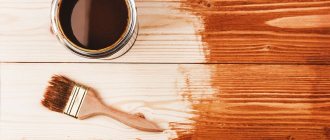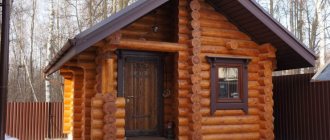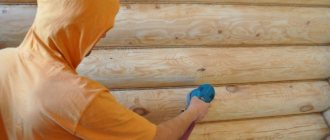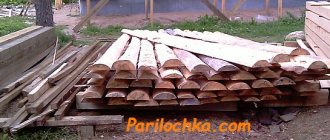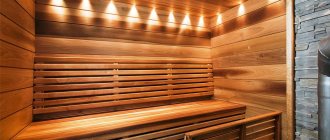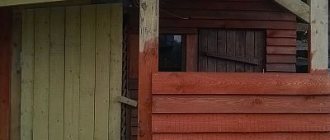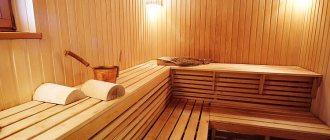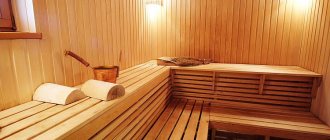The most popular finishing material for a bathhouse is lining; it is made from aspen, alder, pine, and linden boards are often used. This type of cladding is characterized by high performance characteristics: strength, resistance to moisture, steam, and temperature changes.
In order for the wood used to last as long as possible, it must be coated with special compounds that protect against the formation of rot and deformation.
Why is there impregnation in the bath?
Since wood is a natural and absolutely safe material, it is often used for interior decoration. But at the same time, it strongly absorbs moisture, as a result of which the surface becomes loose and is an excellent habitat for microorganisms, in particular fungi. Bacteria that have settled in wooden cladding through their vital activity provoke deterioration of the material and the collapse of the structure.
The market offers a fairly wide range of impregnations for saunas and baths, which are capable of creating a coating that protects the casing from the destructive effects of high humidity and temperature changes. In addition, they have excellent antiseptic properties. The undeniable advantage of such products is the ability to give the surface an attractive appearance, performing the function of a decorative finish.
Note! When choosing impregnation for baths and saunas, you should give preference to products that do not emit toxic substances.
Antiseptic impregnation for a bath allows you to extend the service life of the internal lining, preserve its appearance, and protect it from rotting and mold. These are unique products that do not form a film on the surface of the wood and do not prevent it from breathing.
Precautionary measures
Many products require human protection when working, for this you need to wear gloves and safety glasses, and contact of materials with the skin should be avoided. They must be stored out of the reach of children.
Many products require human protection when working; for this you need to wear gloves and safety glasses.
The article described in detail how you can varnish a bathhouse. Choosing a quality product will ensure a beautiful and reliable coating that will highlight the grain of the wood itself, without harming human health. And the structure itself will last longer.
What to choose
Specialized retail outlets offer a huge number of impregnations for wooden surfaces; they differ in use, form, and composition.
Before you make a purchase of one or another protective equipment, it is recommended to clearly determine what tasks it should cope with, namely:
- what surface will be treated (floor, ceiling, benches, shelves in the steam room, the entire room);
- will an additional decorative coating be used or will the surface after treatment remain the same as before;
- will the degree of moisture protection inside the bath be sufficient;
- Is the application method convenient?
An essential indicator of high-quality impregnation for baths, including those made from logs, is the combination of its moisture-proof properties with the ability not to prevent the skin from breathing. Since the presence of film leads to blockage of the wood structure and subsequent problems leading to damage to the surface. It is also worth paying attention to the environmental friendliness of the selected antiseptic. Otherwise, low-quality goods at high temperatures and high levels of humidity in the room will release harmful substances.
If impregnation is selected for treating floors, then after its application there should not be a slippery coating. Tabletops and benches should be treated with products designed for regular wet cleaning. There are shelf impregnations on sale that can completely penetrate the wood structure and prevent the formation of burns on the body at high temperatures.
Using wood stain
The wood surface should be painted with stain in the same way as with regular paint. The only thing is that this impregnation dries very quickly, so you should work just as quickly, but carefully .
Before completing the work, you must not allow the stain layer to dry, otherwise a seam in this place will be clearly visible, different from the rest of the surface. That is why you should not put a lot of solution on the brush.
To paint a wooden surface with stain, use:
- Paint brush.
- Foam roller.
- Automatic or manual sprayer.
The stain is applied parallel to the direction of the wood grain and therefore should not be applied to another section unless the first is finished. In the place where the two sections are connected, it is necessary to ensure that the applied layers of impregnation do not overlap each other.
Thanks to stain, wood acquires a refined and excellent color . In addition, it protects and enhances the wood grain. After the planed plank floor is laid, it is necessary that it is always clean, otherwise, after applying the stain, all the stains will begin to stand out.
If there are greasy stains on the floor, the stain in this area may not be absorbed into the wood. If the wooden parquet is in good condition and there is no need to restore or putty it, then covering it with such impregnation is an excellent solution to renew the old parquet.
If you need to get a new shade, you can mix several stain colors. You need to stir carefully so that splashes do not fall on the floor, as such stains will subsequently stand out very strongly. It is recommended to mix only compatible components.
Kinds
Protective impregnations for wooden surfaces are divided into groups depending on the main component in their composition, as well as on the properties and method of application. According to the form of release, antiseptics are:
- aerosol;
- gel;
- in the form of a solution.
All types of impregnations for baths and saunas have water-repellent properties. Modern impregnations for baths rarely have only one function; they can often be used as universal preparations that can also protect wooden surfaces from the negative effects of elevated temperatures, excessive humidity and from damage by pathogenic microorganisms and harmful insects.
Based on their composition, the products are divided into water-soluble and oil-based. You can purchase a combined product in the form of varnish and paint, which is characterized by the effect of moisture protection and prevention from microorganisms. Most impregnations have additional performance qualities in the form of fire resistance and dirt-repellent function.
We expose the “concealment” or protective coverings of the wooden walls of the bathhouse
The durability of the coating on a wooden surface depends not only on the composition of the product applied, but also on the tool used, application conditions, number of layers, etc.
If you purchased a store-bought product for bath shelves, the instructions will tell you what to use. However, there are not many options.
Either it will be a brush (pay attention to the instructions - in some cases they write that it should be made of natural bristles), or a clean cloth. In some cases, you can use a sprayer.
Again, different impregnation compositions can be either ready-to-use or require heating.
If you use homemade impregnation, then before starting work you need to heat it to 50-60 degrees.
The brush is used only if the impregnation is sufficiently liquid. The stripes it applies should not overlap so that “steps” are not created (this applies to hardening impregnations). The brush is very convenient for applying oils.
A rag is better for waxing. When rubbing the thick mixture, try to distribute it evenly, but you don’t have to remove the excess right away. If, after applying the layer, you heat the oven, then there will be a classic “waxing” - the wax itself will spread as it should. (When waxing items not for a bath, they are heated with a hairdryer or burner.)
How many layers
The number of layers of impregnation is also usually specified in the instructions. Since the means are different, we will only venture to roughly name the number of layers and the time interval between them. Let's say it's two coats applied one hour apart.
The number of layers depends on both the properties of the impregnation and the porosity of the wood. The more pores, by the way, the higher the consumption of the product - it can increase by about two times.
ADVICE! Take your time to use the soaked shelf. Give it at least a day to absorb. Longer is better, because the point of using polymerizing oils is to let them dry. It's like oil painting - when the paint dries, the layer hardens completely.
Regarding the drying time: they are also different, in some cases a day is enough (according to the instructions), in others the time can last up to two weeks.
The answer to this question depends on what tool you used. The fact is that oil impregnation, although it is easier to apply than wax impregnation, also lasts much less than the latter.
So, for renewing a layer of oil impregnation, the period is called from six months to 2 years, and for wax impregnation - several years (without specification).
However, you should focus on the condition of the wood. If you used tinted impregnation, then you can see from it exactly where it came off. If the impregnation is colorless, focus on the condition of the wood - has it become wetted with water and swollen from it? In these cases, of course, there is no need to wait for the time promised by the manufacturer.
When thinking about how to process wood in a bathhouse, you first need to prepare the necessary tools and buy additional materials:
- Solvent;
- Stirring brush;
- Roller;
- It is recommended to purchase a spray gun, but you can apply the varnish in other ways;
- Sponge;
- Paint tray;
- Protective equipment (respirator, goggles, gloves and overalls).
It is important to remember that the impregnation of the sheathing must be carried out strictly before its installation. It is also necessary to process the sheathing on which the lining will be attached. After the impregnation has dried, you can sheathe the room.
Having completed the installation work, it is necessary to process the wood again. It is important to note that it is important to carry out such treatment approximately once every 2 years, because the coating on the wood takes the “blow” and wears out, keeping the wood in the bath.
Now you know how to treat the lining in a steam bath, but such treatment will not be able to completely protect your bath, so you will have to monitor the room, following some rules:
- Always ventilate the area to minimize the chance of mold or mildew forming;
- The room must be washed frequently with a wet cloth, without using chemical detergents;
If serious contamination appears on the surface of the wood, or it has darkened, then use sandpaper. You can also use special bleaches for wood, but under no circumstances use bleach solutions, because when heated they release a huge amount of toxins, and they can even leave a burn on the skin.
I will opt for spruce as the most affordable material in my region. Now all that remains is to choose an antiseptic and paint for treating the walls of the bathhouse and steam room. I will further refer to the following means of protecting wooden surfaces as paints: varnishes, enamels, azures and some types of impregnants. Spruce is dry, so I choose a water base for protection.
Strictly speaking, water-based protective agents are characterized by the depth of penetration into wood, the amount and composition of fine solutions of acrylic resins, alkyd-acrylic and alkyd emulsions, which make it possible to protect at the biological level from fungi and mold. This very depth of penetration (seepage) depends on how finely dispersed the solutions of our paints are.
Bioprotection protects all layers of wood from rot and fungi. The fire retardant forms a film-layer that prevents oxygen from entering the possible combustion zone and contains salts that inhibit the oxidation (combustion) reaction; the paint prevents the washing out of all of the above protective agents by precipitation and protects the wood from ultraviolet exposure to the sun.
And now the most terrible confession for DIY sauna builders, which can be made based on the content of the last paragraph: The black sauna is the most durable! We are not talking about a black sauna - we are talking about the color of the sauna. The darker the paint, azure or other coating on the external walls of the bathhouse, the more durable the sun protection.
Another secret in choosing paint for a timber bathhouse is related to the fact that the log house will be subject to constant temperature changes over a wide range - from minus 25 to plus 120 degrees. Not every paint can withstand such a load. Elasticity is another coating parameter. If the paint is not elastic, then cracks occur when it deforms and water gets into the wood. Constantly updating the coating is the key to the long service life of a log bathhouse.
Differences between oil and water soluble products
The main distinguishing feature of water-soluble impregnations is the base on which they are made - acrylic. An additional component of the product is usually a special coloring color, which gives the treated sauna lining a certain shade. Acrylic impregnations with varnish are now very popular. They are used to treat baths inside and outside.
Despite the many positive characteristics of acrylic preparations, they have one drawback - gradual leaching from the wood structure. To maintain the natural cladding, it is necessary to carry out regular treatments. An excellent solution to this problem would be to first coat the surface with a waterproofing solution and then with bath impregnation. With such an integrated approach, the wood will last much longer.
Due to the absence of color and odor in acrylic, such preparations are especially suitable for interior work. This is a good option for those owners of baths and saunas who want to preserve the natural wood grain. On sale, water-soluble products are presented in the form of dry mixtures or ready-to-use solutions.
Oil impregnations are distinguished by their ability to penetrate deeply into the wood base, leaving a thin film on the outside. They are characterized by durability and can maintain their performance much longer, even at excessive levels of humidity, than water-soluble preparations.
Oil impregnations are characterized by a high degree of toxicity and the presence of an unpleasant, pungent odor, since they contain a solvent. Due to their toxicity, it is not recommended to use these substances indoors without following safety regulations. They can be used to treat the dressing room, outside walls, and utility rooms.
How to treat the floor and shelves: varnish coatings in the steam room
How to paint the shelves in the bathhouse and can I use varnish for this? Of course it is possible. However, not any varnish coating is suitable for shelves, and even more so for a steam room in a bathhouse.
Important! The safest are acrylics from the company Tikkurila, already known to us.
They are made on a natural basis, and the finished product is heat-resistant, as well as a fairly large selection of colors and shades.
Before painting the lining in a bathhouse with varnish, you should familiarize yourself with its main advantages and disadvantages.
The advantages include:
- Antiseptic in the composition, so before coating it is not necessary to use additional substances to prepare the surface;
- The film formed on the varnished surface does not allow moisture to pass into the wood;
- The varnish coating does not lose its properties even at temperatures above 100 degrees;
- An abundance of colors from which you can choose the one that suits you, or use clear varnish.
You should apply the varnish responsibly.
The first step is to sand the surface of the shelf. This should be done starting with the largest nozzle and ending with the smallest.
Attention! The smallest nozzle performs a polishing role.
After polishing the shelves, wipe them with a damp cloth to remove any remaining sawdust, dust and dirt. Once the wood has dried, you can begin applying varnish. To do this you need to use a brush or roller.
It is very important to ensure that each part is coated with varnish. For hard-to-reach areas, we recommend using a thin brush or sponge
Information. In order not to make a mistake with the choice of colored varnish, it is first recommended to apply it to a small area in two layers to finally make sure that your choice is correct.
Processing different parts of the bath
Conditions in different parts of the bathhouse are different, therefore the requirements for finishing materials are different. In rooms where temperature and humidity are maintained at high levels, it is recommended to choose more expensive durable impregnations.
Waiting room
Among the most popular ready-made products are Sauna (Belinka) and Supi Saunasuoja (Tikkurila). Of the domestic impregnations, the U-409 remedy has proven itself well. It can be equally effectively used for processing wooden structures in baths, saunas, bathrooms, showers and living spaces. All these impregnations are made using only natural ingredients. After their application, a thin film is formed on the sheathing (eurolining) and logs, which greatly simplifies the removal of contaminants. They contain fungicidal and insecticidal components that help prevent the appearance and proliferation of pathogenic microorganisms in baths and saunas, which is especially important for the dressing room.
Another well-known antiseptic is Eurotex Sauna, which contains wax. A colorless wax antiseptic creates a protective film on the surface of a wooden structure. The product is excellent for treating benches and shelves. Impregnation volume of 2.5 liters is enough for 35 sq. m. After using this product, wood has a more attractive appearance, is easier to clean and retains its original color for a long time. The only drawback that can be noted is the presence of a clear specific smell inside the room, but after 3-5 visits it disappears.
Steam room
Considering that the air temperature and high humidity inside the steam room are very high, a special approach is needed here, in particular, you should know how best to treat the lining in the steam room. Natural oils and wax are suitable for these purposes. Some home craftsmen impregnate the boards with linseed oil with the addition of a natural aromatic composition. Often, from a variety of oils, hemp oil is chosen for impregnation. If you need a more economical option, you can use refined sunflower oil.
There is a fairly large selection of products for treating industrial shelves. These are impregnations from Russian and Eurotex Sauna, and Supi Laudesuoja oil from Tikkuril.
Note! It is not advisable to use ordinary paints and varnishes to protect benches, joists, shelves, walls and ceilings.
Wooden surfaces must breathe - first absorb moisture and then release it. If conventional compositions are used, then such surfaces lose this quality. In addition, in conditions of high humidity and high temperatures, the evaporation of harmful substances that pose a health hazard is added, and the bathhouse no longer becomes a cure for many diseases, as it has been for centuries. This can be compared to finishing a bathhouse or sauna with linoleum or siding, which is strictly contraindicated.
How to update the lining
Over time, the appearance of untreated lining ceases to please the owners. Wood tends to darken from moisture, but there is also soot that eats into the wood. For those who are no longer satisfied with this state of affairs and have decided to update the lining in the bathhouse, we have found tips that will help cope with any problem.
How and with what to remove soot
When carbon is not completely burned in a furnace (completely is CO2 or CO), it is released as an amorphous substance that we call “soot.” Soot deposited on the walls is soot.
Cleaning the lining in a bathhouse from soot is more difficult than it seems at first glance. It eats firmly into the wood. And when you try to wash it with soap and a brush, cleansing does not happen.
There are two proven methods for removing soot - mechanical and chemical.
Mechanically, everything is clear - the contaminated surface must be scraped off using any available method. Either manually or using a power tool - the same grinder with an abrasive wheel. As a result, the top layer of wood is removed, revealing a clean surface, and the result is what you need.
The chemical method does not require physical effort and takes much less time. On sale you can find products that were developed specifically to eliminate soot or soot from a fire.
As an example, let's name SYNTILOR Fuoco, DOCKER MAZBIT PLUS, “Facade Cleaner No. 2” from and the like.
The video clearly shows how the first of these tools works:
But here’s what’s interesting: all compounds that remove soot and soot contain... alkali as the main active component. No one says the composition, but there are just one or two strong alkalis, and their qualities are approximately the same. We mean sodium and potassium hydroxides - KOH and NaOH.
There is nothing stopping you from buying them at a store cheaply, diluting them with water and washing off the soot from the wood.
VERY IMPORTANT! If you don’t want chemical burns, don’t even try to work with alkali without covering your arms and legs with clothing, gloves and glasses. Chemical burns are worse than thermal burns, or rather deeper. And keep an acid solution nearby - vinegar, dilute citric acid - so you can immediately pour the place where the alkali got in. There is no use in rinsing with water!
After the soot disappears, be sure to wash off any remaining lye from the wall. We recommend doing this first with an acid solution (vinegar, lemon) so that the residues are neutralized, and then with clean water.
There is another way, but we like it even less than dangerous alkali. We are talking about a mixture of gasoline and washing powder with water . You already have a fire-hazardous building with a stove; soaking it in gasoline seems unnecessary.
But if you need to wash, say, a fireplace brick , but there is no alkali on hand, you can mix two tablespoons of washing powder, 100 ml of water, 100 ml of gasoline, then vigorously shake the mixture in a bottle and start scrubbing.
In general, it is clear that soot and soot are removed by degreasers. Yes, by the way, burnt baking sheets are washed in the same way as lining - with alkalis.
How to wash the paneling
We have already recommended a way to get rid of blue stains and lighten darkened wood using bleach (by the way, this is just a solution of sodium hypochlorite, bleach - you can prepare it yourself from powder).
BY THE WAY! If someone starts complaining that chlorine vapor will continue to be inhaled for a long time, don’t believe it. Because the smell (and therefore the volatile substances) disappears quickly, and there is no more cause for concern than when working with “Whiteness” at home. But it’s better not to pour it on your hands, of course.
You can do without bleach altogether if you walk over the darkened lining with a sander.
If the task is to get rid of sweat, grease and the like, then it will be enough to wash the lining in a bathhouse with a strong solution of laundry soap . Moreover, what is interesting: laundry soap contains residues of alkali from the saponification of vegetable fat (that’s how it is obtained), so it is not neutral, but slightly alkaline. So it turns out that you are again using alkali, only weak.
Some people may find washing with soap a long time - then just increase the alkaline component. Following the safety precautions described above, of course! Maybe you have a “MOLE” - breed it.
***
This is such a chemical and not only educational program. Like, share links with friends and subscribe to our channel in Telegram.
Homemade recipes
There is a recipe for homemade wax impregnation, which includes beeswax and linseed oil, the ingredients are taken in equal proportions. The grated wax is melted in a water bath, and then it is mixed with the second component and allowed to cool.
It is recommended to use harmless protective materials to impregnate the walls of the steam room. The use of oils allows you to create a greasy film on the surface of a wooden structure and protect the wood itself from penetration deep into dirt. There is one minus here. For some time after contact with the treated surfaces, a greasy film will be felt, but soon the oil will be absorbed and partially erased, leaving only a protective film.
A good result is obtained after using melted natural wax. This impregnation is easy to do with your own hands. But the surface must first be thoroughly cleaned, degreased and only then wax applied.
